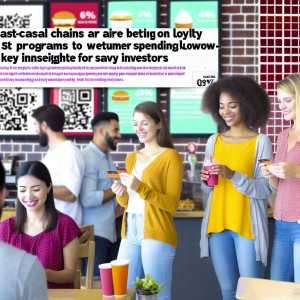In today’s uncertain economic climate, fast-casual dining is facing a pivotal challenge: how to keep customers coming back when wallets are tightening. The answer? Loyalty programs have evolved from mere marketing perks into essential survival tools for restaurant chains. At Extreme Investor Network, we see this trend not just as a passing tactic but as a fundamental shift reshaping how food brands engage with consumers—and it carries profound implications for investors and advisors alike.
Loyalty Programs: The New Cornerstone of Consumer Retention
Data from Circana reveals a striking reality: consumers enrolled in loyalty programs visit restaurants 22% more often annually and patronize those brands at twice the rate of nonmembers. This isn’t just a bump in foot traffic—it’s a structural advantage that translates directly into sustained revenue streams. Starbucks, for example, boasts 34.2 million active rewards members who account for over 59% of U.S. company-owned transactions. Chipotle’s loyalty program drives approximately 30% of its daily sales, helping the brand avoid steep price hikes despite inflationary pressures.
What’s unique here is how these programs foster habitual spending rather than one-off visits. Peter Fader, a marketing professor at Wharton, aptly calls loyalty programs a “required ingredient” in tough economic times. This points to a broader trend: loyalty is becoming a defensive moat that can protect and even grow market share when consumer spending slows.
Beyond Discounts: Creativity and Engagement as Loyalty Drivers
Leading brands aren’t just handing out coupons—they’re innovating to deepen emotional connections. Cava revamped its rewards program to offer flexible point redemption on specific items and introduced playful elements like a mascot and limited-time challenges. This gamification strategy creates “delight moments” that surprise and engage customers, transforming routine transactions into memorable experiences.
Similarly, Chipotle’s “Summer of Extras” campaign, which offers over $1 million in free burritos, leverages social media buzz and competitive fun to amplify engagement. Sweetgreen’s recent simplification of its rewards program reflects a growing industry understanding that clarity and ease of use are crucial for customer retention in a value-conscious market.
What Investors Should Watch—and Do
From an investment perspective, these loyalty strategies are more than marketing gimmicks—they are critical indicators of a brand’s resilience and growth potential. Chains with robust, well-executed loyalty programs are better positioned to weather economic downturns and capitalize on consumer shifts.
Actionable insights for investors and advisors:
-
Prioritize Brands with Scalable Loyalty Platforms: Look for companies investing in technology that personalizes rewards and adapts to consumer behavior. Portillo’s innovative use of a digital wallet system to track visits and award badges without requiring app redesigns is a model of cost-effective scalability.
-
Monitor Engagement Metrics Over Sales Alone: Traditional same-store sales figures can be misleading during economic slowdowns. Instead, track loyalty program membership growth, frequency of visits by members, and digital sales penetration. For example, Potbelly’s shift to a coin-based rewards system increased customer engagement almost immediately, suggesting a direct correlation between program flexibility and revenue lift.
-
Watch for Margin Pressure and Long-Term Payoff: While loyalty programs can cut into short-term profits due to free rewards and promotions, they often drive longer-term customer lifetime value. Investors should assess how brands balance these trade-offs and whether they have clear strategies to convert loyalty members into full-price buyers.
The Next Wave: Data-Driven Personalization and Emotional Connection
Looking ahead, the most successful loyalty programs will harness data analytics to deliver hyper-personalized offers that resonate on an individual level. This goes beyond generic discounts to creating unique value propositions tailored to each customer’s preferences and habits. Moreover, emotional branding—like Cava’s mascot or Chipotle’s social competitions—will play a growing role in building communities around food brands.
A Unique Statistic to Consider
According to a recent survey by McKinsey, 70% of consumers say they are more likely to remain loyal to brands that offer personalized rewards and experiences. This underscores the importance of moving beyond traditional points systems to innovative, customer-centric loyalty models.
Final Thought: What Should Advisors Tell Clients?
Advisors should encourage clients to consider restaurant stocks not just on traditional financial metrics but on their loyalty program strategies and digital engagement capabilities. As consumer behavior shifts, brands that can build habitual, value-driven relationships with customers will outperform peers. This is a nuanced factor that many mainstream analyses overlook but one that Extreme Investor Network highlights as a key to future-proofing restaurant investments.
In summary, loyalty programs in the fast-casual sector are no longer optional extras—they are strategic imperatives redefining competitive advantage. Investors who grasp this dynamic and act accordingly stand to gain from the next chapter in consumer-driven growth. Stay tuned as we continue to track which brands innovate best and deliver the strongest returns in this evolving landscape.
Source: Fast-casual restaurants lean on loyalty programs amid consumer pullback

